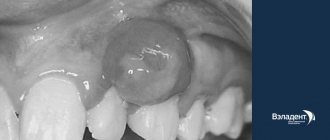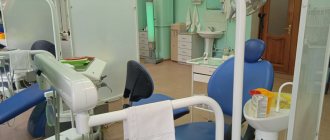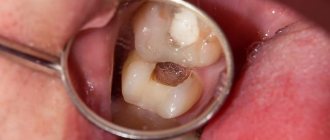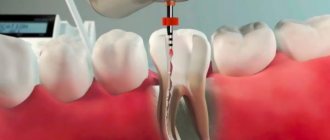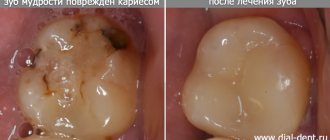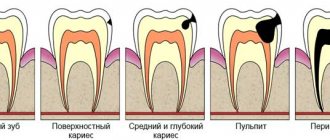What is pulpitis
Pulpitis is an inflammatory process inside a tooth. It passes through the neurovascular bundle - the pulp. This is a soft tissue that runs through the entire tooth and helps provide it with proper nutrition. It is reliably protected from external influences by dental bone tissue, but any violation of its integrity leads to severe pain and inflammation.
At an early stage, the disease can still be cured, but if this is not done, the infection can spread to the bone tissue, resulting in periodontitis. And this is not just a word or pain, it is a high risk of tooth loss. Dangerous bacteria will literally destroy the nerve, forming a large amount of pus. Because of this, gumboil develops and the sore spot becomes very swollen and painful. And in such cases it is no longer possible to do without the help of a surgeon. To prevent this from happening, pulpitis must be treated at the earliest stages. But how not to confuse it with other dental diseases?
Folk remedies
In addition to traditional remedies used to relieve pulpitis, traditional medicine will also help relieve pain. Here is a small list of the most effective of them:
- A couple of drops of clove oil, applied to a small piece of cotton wool and applied to the sore spot, will reduce the severity of pain after some time. You can also try applying dried cloves, only before applying it you need to chew it a little, otherwise the essential substance will not be released;
- Fresh or salted lard applied to the inflamed area relieves pain well;
- Gargling with decoctions of St. John's wort, sage, chamomile, cloves, and elderberry flowers is very useful. You can also use an infusion of wine vinegar and mint and raspberry leaves. However, the preparation time for such an infusion is three days, so there is no need to talk about emergency assistance when using it;
- Another version of the decoction is prepared from two tablespoons of chopped turnips, which is poured with a glass of boiling water and boiled for ten to fifteen minutes;
- Suitable for relieving pain and rinsing with water with a drop of tea tree oil, as well as a solution of salt and soda;
- Alternative medicine also suggests applying the following remedies to an inflamed tooth: ice, raw beets, a leaf or stem of wild garlic crushed to a pulp, leaves of coltsfoot or horse sorrel, plantain root, juice from angelica leaves, propolis, “Asterisk” balm. , iodine (you should be very careful with the last three remedies, as they can severely burn the soft tissue of the gums and cheeks);
- Acupressure in the area of the inflamed area is very effective in reducing pain, if it does not cause even more pain.
One of the most favorite means of relieving all types of pain in Russia is alcohol. However, most often they try to take it orally, which should not be done, since pulpitis and alcohol are bad traveling companions. The only correct use of alcohol-containing drinks for inflammation is applying a moistened cotton swab or rinsing, but even here it is important to remember a few simple rules:
- Do not use pure alcohol!
- Do not rinse your mouth with sugar-containing drinks; only pure ones will do: gin, vodka, whiskey, cognac.
- Do not swallow the drink after rinsing.
Of course, alcohol can relieve pain for a short time and disinfect the problem area, but it will not cure inflammation.
Despite the fact that all these methods relieve pain for a short time, pulpitis still cannot be cured with tablets, so you should not put off visiting a doctor. Even if you are very afraid to treat pulpitis, anesthesia will make this procedure completely painless and quick. The process of tooth depulpation is carried out as follows: the damaged area is drilled out, the doctor uses special tools to remove the inflamed pulp and cleans the tooth cavity. If it is not possible to completely clean out all the soft tissue, arsenic, or rather a paste containing this substance, is used to treat pulpitis. It mummifies and dissolves the remaining pieces of nerve and pulp. Then the tooth cavity is thoroughly cleaned, disinfected and sealed.
Symptoms of pulpitis
In medicine, pulpitis is divided into acute and chronic. Each species has several subtypes, which are characterized by their own characteristics. If you make a correct diagnosis right away, then serious consequences can be avoided.
Acute pulpitis - often occurs due to complications in the development of dental caries. It can be immediately determined due to the effect on the tooth - severe pain occurs, which often torments patients at night. The disease can occur in two forms:
• focal - from the name it follows that the focus of inflammation is located directly in one place not far from the cavity affected by caries. This stage can be called the initial stage; it lasts about two days. Patients are worried about acute pain that suddenly appears in the tooth. Moreover, sometimes it appears randomly, subsiding after 10-15 minutes, and then returning with renewed vigor. It is quite easy to understand which tooth hurts, since the pain during this period is well localized; • diffuse - the next and more serious form, due to which the coronal and root parts of the pulp suffer. During this period, it is difficult for the patient to determine the source of pain, since the discomfort spreads throughout the jaw and even the head. As for the duration of the attacks of pain, they lengthen and in some cases reach 40 minutes. This pain is very exhausting, preventing a person from falling asleep. Diffuse pulpitis can last up to two weeks, after which it enters the chronic stage.
It is worth noting that if hot drinks only increase the pain, and cold drinks reduce the pain, then the patient has already begun the purulent stage of pulpitis.
Chronic pulpitis is a rather insidious inflammation that can last from two weeks to several years, periodically reminding a person of its presence. Chewing on the side of the jaw where the inflammatory process is localized is quite difficult, since irritation returns discomfort to the patient. At this time, bleeding may open in the pulp, and the hard tissues of the tooth are gradually destroyed. There are several types of chronic pulpitis:
• fibrous - this type is hidden and often does not bother the patient, since the pain in this case is rather mild. Sometimes the patient feels aching pain. During the examination, the doctor may find a deep carious cavity in the tooth with an inflamed pulp chamber. Blood may appear there from time to time; • gangrenous - occurs due to infection in the background of the previous stage. In this case, the nerve fibers completely lose their viability, and the pulp itself becomes dirty gray in color. A huge carious cavity forms in the tooth, which increases pain and causes bad breath. • hypertrophic - it will not be difficult for the doctor to determine what kind of case he is faced with. In the resulting dental cavity, granulation tissue grows, which constantly bleeds. Unpleasant sensations in the tooth and bleeding occur when eating solid food. • exacerbation of chronic pulpitis - the end of the life of a tooth. Patients experience severe pain when pressing on the tooth, and the images show bone destruction and periodontal infection.
Modern medicine makes it possible to save a tooth, but it is worth noting that the pulp itself sometimes has to be removed due to irreversible changes that have occurred in the bone tissue of the teeth. But if chronic pulpitis often ends this way, then in the initial stages of the development of the disease, removal can be avoided.
pexels.com/
Treatment methods for pulpitis
Elena Bobkova , a dental therapist at the Dental Hi-Tech clinic, spoke about how pulpitis is treated in a conversation with the Federal News Agency . According to her, the dentist’s manipulations are aimed at eliminating the inflammatory process in the pulp. She noted that there are two methods of treating pulpitis - biological (conservative) and surgical.
“The biological method is used quite rarely. It is mainly used for treatment of tooth injuries or accidental opening of the pulp during the treatment of deep caries. It is also worth paying attention to age - the patient should be no more than 25 years old.”
During treatment, the exposed pulp is treated with non-aggressive antiseptic agents, a special calcium hydroxide gasket is applied to it, and then the whole thing is closed with a temporary filling. If the inflammatory process has been stopped and the tooth no longer bothers you, then a permanent filling is placed.
If we talk about the surgical method, it is divided into vital and non-vital. With the vital method of treatment, a tooth is prepared under local anesthesia: all softened carious tissues are removed, then the tooth cavity is opened, the pulp is removed, the root canals are treated with special instruments, they are expanded and washed with special antiseptics.
“Very often such treatment is divided into several visits. On the first visit, the doctor fills the canals with a temporary filling, and only after the tooth stops bothering the patient, the doctor fills the root canals - either by vertical or lateral condensation of gutta-percha, or by the condensation method of hot gutta-percha. And only on the patient’s next visit, the doctor restores the crown part of the tooth.”
The devitalizing method is the treatment of pulpitis using devitalizing agents. Previously, arsenic paste was used in dentistry; now doctors use more modern and safe means. They are applied for several days to influence the pulp, after which the “killed” nerve is removed and the root canals are again treated and filled, as with the vital method.
Thus, for each patient who is awaiting treatment for pulpitis, there is approximately the following work plan:
• local anesthesia - you cannot do without it, because the pulp is a nerve, touching which will cause sharp pain. However, we advise you to warn the doctor in advance about the presence of allergies to medications, since the doctor should be aware of the possible risks; • elimination of carious cavity. The previously listed treatment methods are used here, depending on the clinical picture; • pulp removal. This is done with a special tool - a pulp extractor; • channel measurement; • treatment of canals and teeth; • installation of fillings in the canals and on the crown of the tooth.
pexels.com/
Reviews
Dentists have a negative attitude towards treating pulpitis at home. In their opinion, folk remedies can relieve a person of pain for a short time, but do not eliminate the cause of its occurrence.
Such methods of therapy are permissible only if it is impossible to get to a doctor on the same day when the first signs of the disease appear. You can share your experience in getting rid of pain caused by pulpitis using alternative medicine in the comments section of the article.
If you find an error, please select a piece of text and press Ctrl+Enter.
What to do if tooth pain persists
According to Dr. Bobkova, patients may experience pain when chewing after root canal filling. However, there is nothing wrong with this phenomenon if the unpleasant sensations disappear after two or three days.
“If the pain has been bothering you for a week or more, then you should consult your doctor. There can be several causes of pain - a fracture of the instrument, perforation in the tooth wall, removal of material beyond the apex of the tooth, or an additional canal was missed during the treatment process. Therefore, you cannot endure the pain; it is better to immediately contact your doctor.”
Pulpitis in children
Treatment of pulpitis in children follows the same scheme, but there are a number of difficulties here. Firstly, the inflammatory process in the tooth itself occurs very quickly, so it is important to prevent it from spreading to the bone tissue around the tooth. Secondly, a child may experience an allergic reaction to anesthesia during treatment.
Therefore, in the case of children, it will be much easier to initially monitor the condition of the teeth and prevent the occurrence of caries. If your child complains of toothache, you should not put off visiting the dentist. After all, the health of permanent teeth depends on the speed of treatment.
Probably no one wants to get such dental problems. To avoid them, you need to visit the dentist once every six months, have an examination and professional cleaning, eat right, give up bad habits and keep your mouth clean. After all, dental health is only in your hands.
Causes of inflammation of the dental nerve
Infection in the pulp.
Most often this happens as a result of complications of untreated caries. The carious cavity expands, bacteria penetrate into the pulp and infect it. The infection can also enter the pulp through the apex of the tooth root from deep periodontal pockets with gum disease or through blood from other foci of infection.
Tooth trauma with damage to the pulp chamber, bruxism.
Even a small crack in the tooth enamel can allow bacteria from the oral cavity to penetrate into the pulp and cause inflammation. Therefore, any, even minor, tooth injury requires consultation with a dentist and subsequent observation if there is a suspicion of opening of the pulp chamber. If there is an open pulp, the tooth requires urgent endodontic treatment.
Doctor's mistakes.
Incorrect actions by the dentist can also damage the pulp and provoke inflammation. This may happen if:
- the tooth was treated with too aggressive alcohol or alkaline solutions during treatment,
- the pulp was overheated during the preparation of tooth tissue without sufficient cooling,
- the pulp chamber was damaged due to negligence during the treatment of caries,
- a filling material was used that caused an allergic reaction in the patient.

